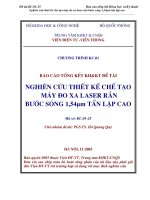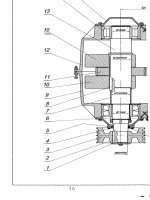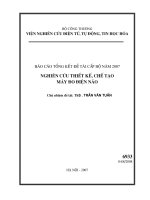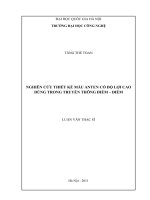Nghiên cứu thiết kế mẫu anten có độ lợi cao dùng trong truyền thông điểm – điểm
Bạn đang xem bản rút gọn của tài liệu. Xem và tải ngay bản đầy đủ của tài liệu tại đây (708.49 KB, 11 trang )
ĐẠI HỌC QUỐC GIA HÀ NỘI
TRƯỜNG ĐẠI HỌC CÔNG NGHỆ
TĂNG THẾ TOAN
NGHIÊN CỨU THIẾT KẾ MẪU ANTEN CÓ ĐỘ LỢI CAO
DÙNG TRONG TRUYỀN THÔNG ĐIỂM – ĐIỂM
LUẬN VĂN THẠC SĨ
Hà Nội - 2011
ĐẠI HỌC QUỐC GIA HÀ NỘI
TRƯỜNG ĐẠI HỌC CÔNG NGHỆ
TĂNG THẾ TOAN
NGHIÊN CỨU THIẾT KẾ MẪU ANTEN CÓ ĐỘ LỢI CAO
DÙNG TRONG TRUYỀN THÔNG ĐIỂM – ĐIỂM
Ngành: Công nghệ Điện tử - Viễn thông
Chuyên ngành: Kỹ thuật Điện tử
Mã số: 60 52 70
LUẬN VĂN THẠC SĨ
NGƯỜI HƯỚNG DẪN KHOA HỌC: PGS.TS Trương Vũ Bằng Giang
Hà Nội - 2011
5
MỤC LỤC
LỜI CẢM ƠN 3
LỜI CAM ĐOAN 4
MỤC LỤC 5
DANH MỤC TỪ VIẾT TẮT 7
DANH MỤC HÌNH VẼ 8
DANH MỤC BẢNG BIỂU 10
MỞ ĐẦU 11
CHƢƠNG 1 12
KHÁI QUÁT VỀ CÁC HỆ THỐNG ANTEN ĐỘ LỢI CAO 12
1.1. Các hệ anten độ lợi cao trong thông tin điểm-điểm 12
1.1.1. Khái niệm chung 12
1.1.2. Các đặc tính quan trọng của anten độ lợi cao 13
1.1.3. Anten Yagi (Yagi antenna) 14
1.3.4. Anten Loa (Horn Antenna) 16
1.1.5. Anten thấu kính (Lens Antenna) 17
1.1.6. Anten parabol (Parabol Antenna) 18
1.1.7. Anten mảng (Aray Antenna) 19
1.1.8. Tổng quan các hệ anten độ lợi cao 19
1.2. Hệ anten mới có độ lợi cao: Anten có cấu trúc đặc biệt EBG (Electromagnetic
Band Gap) 21
1.2.1 Giới thiệu anten có cấu trúc đặc biệt EBG 21
1.2.2. Ƣu điểm và nhƣợc điểm của anten EBG 21
1.3. Kết luận chương 1 22
Chƣơng 2. CẤU TẠO VÀ NGUYÊN LÍ HOẠT ĐỘNG CỦA ANTEN CÓ CẤU
TRÚC ĐẶC BIỆT EBG 23
2.1. Vật liệu có cấu trúc đặc biệt EBG 23
2.1.1. Giới thiệu về vật liệu EBG 23
2.1.2. Định lí Bloch và đồ thị tán sắc 24
2.1.3. Các phƣơng pháp mô hình hóa cấu trúc EBG 26
2.1.4. Ứng dụng của EBG trong thiết kế Anten 27
2.2. Cấu tạo của anten EBG 30
2.3. Nguyên lý hoạt động của anten EBG 31
2.3.1. Mô hình anten EBG 31
2.3.2. Nguyên lý hoạt động của Anten EBG 35
2.4. Kết luận chương 2 41
Chƣơng 3 42
6
THIẾT KẾ, MÔ PHỎNG ANTEN EBG DÙNG TRONG TRUYỀN THÔNG
ĐIỂM-ĐIỂM 42
3.1. Yêu cầu thiết kế 44
3.1.1. Thông số đầu vào 44
3.1.2 Lựa chọn mô hình thiết kế 44
3.2. Quy trình thiết kế 45
3.2.1 Thiết kế bề mặt bán phản xạ: 45
3.2.2 Các thông số thiết kế về kích thƣớc của hộp cộng hƣởng 46
3.3. Mô phỏng dựa trên phần mềm 4NEC2 47
3.3.1 Giới thiệu phần mềm 4NEC2 47
3.3.2 Thiết kế anten trên 4NEC2 49
3.3.3 Đặc tính phối hợp trở kháng 52
3.3.4 Các đặc tính kỹ thuật khác của Anten 53
3.4. Kết luận chương 3 55
KẾT LUẬN CHUNG 57
1. Đóng góp của đề tài 57
2. Hướng phát triển của đề tài trong tương lai 58
TÀI LIỆU THAM KHẢO 59
NGHIÊN CỨU THIẾT KẾ MẪU ANTEN CÓ ĐỘ LỢI CAO
DÙNG TRONG TRUYỀN THÔNG ĐIỂM-ĐIỂM
Học viên: Tăng Thế Toan
Chuyên ngành: Kỹ thuật Điện tử
Ngành: Công nghệ Điện tử - Viễn thông
Khoa: Điện tử - Viễn thông
Email:
Giáo viên hướng dẫn: PGS.TS Trương Vũ Bằng Giang
Cơ quan công tác: Khoa Điện tử - Viễn thông
Trường Đại học Công nghệ - ĐHQGHN
Email:
Anten là một phần tử không thể thiếu
được trong mọi hệ thống thông tin liên lạc vô
tuyến. Anten có độ lợi cao là loại anten có
khả năng phát sóng tập trung vào một hướng
nhất định và duy nhất, nó cho phép hệ thống
truyền thông ít bị ảnh hưởng bởi nhiễu đến từ
các hướng khác, cho phép tăng cự li thông tin,
làm giảm giá thành chung của hệ thống viễn
thông.
Trong luận văn này, tôi tập trung vào
một loại anten có độ lợi cao sử dụng trong
truyền thông điểm-điểm: anten EBG
(Electromagnetic Band Gap-Dải chắn điện
từ). Đó là một loại anten mới trên thế giới và
nó vẫn còn đang được phát triển và nghiên
cứu.
I. Khái quát về các hệ thống anten có độ lợi
cao
Trình bày khái quát các hệ anten có độ
lợi cao ứng dụng trong truyền thông điểm-
điểm và giới thiệu khái quát mẫu anten có độ
lợi cao thế hệ mới: anten EBG.
II. Cấu tạo và nguyên lí hoạt động của
anten có cấu trúc đặc biệt EBG
Trên cơ sở lí thuyết về cấu trúc vật liệu
đặc biệt EBG và nguyên lí hộp cộng hưởng
Fabry Perot, đề tài trình bày cấu tạo của mẫu
anten EBG và tính toán lí thuyết các thông số
hoạt động mẫu anten này.
III. Thiết kế, mô phỏng anten EBG dùng
trong truyền thông điểm-điểm
Áp dụng những kiến thức khái quát và
cơ sở lí thuyết đã trình bày trên đề tài đã xây
dựng được qui trình thiết kế anten độ lợi cao:
anten EBG dựa trên tiêu chí kĩ thuật đầu vào
là độ lợi (gain) và tần số (frequency). Cuối
cùng, mẫu thiết kế một anten EBG hoạt động
với độ lợi 21 dB ở tần số làm việc khoảng
2.35GHz được trình bày và xác nhận bằng
cách mô phỏng trên phần mềm ứng dụng
4NEC2.
IV. Kết luận chung
Kết quả mô phỏng bằng máy tính cho
thấy mẫu anten này đã cải thiện được đáng kể
những đặc tính kỹ thuật của một anten cao tần
về đồ thị bức xạ, độ lợi so với trường hợp
anten không sử dụng cấu trúc EBG. Đồng
thời mẫu anten mới cũng thể hiện được những
ưu điểm về hình dạng, kích thước hình học so
với các anten có độ lợi cao hiện đang sử
dụng.
Đề tài có thể được triển khai ứng dụng
trong các hệ thống truyền thông điểm-điểm,
hay các ứng dụng cho anten trạm phát sóng
BTS 3G, 4G, ứng dụng trong thông tin vệ
tinh.
TÀI LIỆU THAM KHẢO
A. Tiếng Việt
[1] Bộ môn Thông tin vô tuyến Khoa Điện
tử Viễn thông, Trường Đại học Công
nghệ, Đại học Quốc Gia Hà Nội
(2008), Thực hành Kỹ thuật anten.
[2] GS. TSKH Phan Anh (2007), Lí thuyết
và kỹ thuật anten, Nhà xuất bản Khoa
học và Kỹ thuật, Hà Nội.
[3] Trần Thế Phương (2009), Thiết kế
anten dùng trong công nghệ truyền
thông vô tuyến băng siêu rộng (UWB)
sử dụng vật liệu có cấu trúc đặc biệt,
Luận văn thạc sỹ, Đại học Bách Khoa
Hà Nội.
B. Tiếng Anh, Pháp
[4] Shuch, H.P., A brief history, in The
ARRL UHF/Microwave Experimenter's
Manual, A.R.R. League, Editor. 1990,
Newington CT: Newington.
[5] Trentini, G.V., “Partially reflecting
sheet arrays“. IRE Trans. On
Antennas and Propagation, 1956.
[6] Thevenot, M., "Directive Photonic-
Bandgap Antennas". IEEE Trans.
Antennas Propag, 1999.
[7] Cyril Cheype, C.S., Marc Thèvenot,
Thierry Monédière, Alain Reineix, et
Bernard Jecko, An Electromagnetic
Band Gap Resonator Antenna ". IEEE
Trans. on Antennas.and Propagation,
2002.
[8] L. Bernard, et al., "Novel superstrate
gainenhanced antenna with lateral
metallic walls" Microw. Opt. Tech.
Lett, 2004.
[9] M. Diblanc, et al., "Circularly
Polarized Metallic EBG Antenna ".
IEEE Microwave and Wireless
Components Letters, 2005.
[10] A. R. Weily, et al., "A Planar
Resonator Antenna Based ona
Woodpile EBG Material" IEEE Trans.
on Antennas.and Propagation, 2005.
[11] M. Thevenot, C. Cheype, A. Reineix,
B. Jecko, "Directive photonic-bandgap
antennas", IEEE Transactions on
Microwave Theory and Techniques,
Volume: 47 Issue: 11, Novembre
1999.
[12] Yeh, P., Optical Waves in Layered
Media, ed. J.W. Son. 1988.
[13] Brillouin, L., "Wave guides for slow
waves". Journal of Appl. Phys., 1948.
[14] Electromagnetic Band Gap (EBG) For
Microstrip Antenna, Ainor Khaliah
binti Mohd Isa, Universiti Teknologi
Malaysia, MAY 2007.
[15] Fan Yang, Yahya Rahmat-Samii
(2008), Electromagnetic Band Gap
Structures in Antenna Engieering,
Cambrigde University Press, UK.
[16] R. Gonzalo et al., “Enhanced patch
antenna performance by suppressing
surface waves using photonic bandgap
substrates,” IEEE Trans. Microw.
Theory Tech., 1999.
[17] R. Gonzalo et al., "Radiation
properties ot terahertz dipole antenna
mounted on photonic crystal ".
Electron. Lett, 2001.
[18] G. Poilasne, P.P., K. Mahdjoubi, L.
Desclos et C. Terret, “Antenna beam
forming using active metallic photonic
band-gap materials ”. IEEE APS99,
1999.
[19] A. R. Weily, et al., "A Planar
Resonator Antenna Based ona
Woodpile EBG Material" IEEE Trans.
on Antennas.and Propagation, 2005.
[20] Sauleau, R., " Etude de résonateurs de
Pérot-Fabry et d'antennes imprimées
en ondes millimétriques. Conception
d'antennes à faisceau gaussien ". 1999,
Thèse de l'Université de Rennes 1:
Rennes.
[21] NEC based antenna modeler and
optimizer by Arie Voors
(
[22] Simulation of Wire antennas using
4NEC2, Author: Gunthard Kraus,
Oberstudienrat, Elektronikschule
Tettnang, Germany August 15
th
, 2010.
[23] Antenna Engineering, Peter Knott
(h-
aachen.de/fileadmin/lehre/AntennaEng
ineering)./.
RESEACH DESIGN HIGH-GAIN ANTENNAS
IMPLEMENTING IN POINT-POINT COMMUNICATION
Student name: Tang The Toan
minor, major, Department: Electronics Engineering,
Electronic Technology, Electronics and
Telecommunication
email:
Professor name: A.Prof. Dr. Truong Vu Bang Giang
Affiliation: University of Engineering and Technology
Email:
The antenna is an essential element in all
radio communication systems. High-gain
antenna is an antenna which is capable of
broadcasting on a certain and unique direction,
it allows communication system to be less
susceptible to interference from other
directions, to increase information distance,
reducing the overall cost of telecommunications
systems.
In this thesis, I focus on a high-gain
antenna used in point-point communication:
EBG antenna (Electromagnetic Band Gap). This
kind of antenna is new in the world and it is still
in the stage of development and research.
I. Overview about high – gain antenna
applied in point-point
The thesis, gives an overview about high
– gain antenna applied in point-point
communication and introduces briefly the new
generation high-gain antenna: EBG antenna.
II. Structure and principle of the antenna
with EBG special structure
On the basis of the theory on the
structure of EBG special material and the
principle of Fabry Perot resonator, the thesis
presents the structure of the EBG antenna
sample and calculates theoretically operating
parameters of this antenna.
III. Design, simulation EBG antennas
implementing in point-point communication
Applying the general knowledge and the
theoretical basis presented above, the thesis has
established the design procedures of the high-
gain antenna: EBG antenna based on the
technical input criteria: gain and frequency.
Finally, the design sample of an EBG antenna
operates with 21 dB gain at the working
frequency around 2.35GHz is presented and
verified by simulating on applied software
4NEC2.
IV. General conclusions
The results from computer simulations
show that this kind of antenna has improved
considerably the technical characteristics of a
high frequency antenna in terms of radiation
pattern and gain in comparison with the antenna
without EBG structures. The new antenna also
demonstrates the advantages of shape,
geometric dimension compared with the high-
gain antenna which is in use now.
The thesis can be applied in the point -
point communication system, or the application
for broastcasting antenna stations BTS 3G, 4G,
the applications of satellite communication.
REFERENCES
A. Vietnamese
[1] Department of Information Science Radio
Electronics and Telecommunications,
University of Technology, Hanoi National
University (2008), Antenna Engineering
Practice.
[2] GS. Prof. Phan Anh (2007), antenna theory
and techniques, Publishing House of
Science and Technology, Hanoi.
[3] Tran Phuong (2009), Designing antennas
used in wireless communications
technology ultra-wide band (UWB) use
structural materials in particular, Master
Thesis, Hanoi University of Technology.
B. English, French
[4] Shuch, H.P., A brief history, in The
ARRL UHF/Microwave Experimenter's
Manual, A.R.R. League, Editor. 1990,
Newington CT: Newington.
[5] Trentini, G.V., “Partially reflecting
sheet arrays“. IRE Trans. On Antennas
and Propagation, 1956.
[6] Thevenot, M., "Directive Photonic-
Bandgap Antennas". IEEE Trans.
Antennas Propag, 1999.
[7] Cyril Cheype, C.S., Marc Thèvenot,
Thierry Monédière, Alain Reineix, et
Bernard Jecko, An Electromagnetic Band
Gap Resonator Antenna ". IEEE Trans.
on Antennas.and Propagation, 2002.
[8] L. Bernard, et al., "Novel superstrate
gainenhanced antenna with lateral
metallic walls" Microw. Opt. Tech. Lett,
2004.
[9] M. Diblanc, et al., "Circularly Polarized
Metallic EBG Antenna ". IEEE
Microwave and Wireless Components
Letters, 2005.
[10] A. R. Weily, et al., "A Planar Resonator
Antenna Based ona Woodpile EBG
Material" IEEE Trans. on Antennas.and
Propagation, 2005.
[11] M. Thevenot, C. Cheype, A. Reineix, B.
Jecko, "Directive photonic-bandgap
antennas", IEEE Transactions on
Microwave Theory and Techniques,
Volume: 47 Issue: 11, Novembre 1999.
[12] Yeh, P., Optical Waves in Layered
Media, ed. J.W. Son. 1988.
[13] Brillouin, L., "Wave guides for slow
waves". Journal of Appl. Phys., 1948.
[14] Electromagnetic Band Gap (EBG) For
Microstrip Antenna, Ainor Khaliah binti
Mohd Isa, Universiti Teknologi
Malaysia, MAY 2007.
[15] Fan Yang, Yahya Rahmat-Samii (2008),
Electromagnetic Band Gap Structures in
Antenna Engieering, Cambrigde
University Press, UK.
[16] R. Gonzalo et al., “Enhanced patch
antenna performance by suppressing
surface waves using photonic bandgap
substrates,” IEEE Trans. Microw.
Theory Tech., 1999.
[17] R. Gonzalo et al., "Radiation properties
ot terahertz dipole antenna mounted on
photonic crystal ". Electron. Lett, 2001.
[18] G. Poilasne, P.P., K. Mahdjoubi, L.
Desclos et C. Terret, “Antenna beam
forming using active metallic photonic
band-gap materials ”. IEEE APS99,
1999.
[19] A. R. Weily, et al., "A Planar Resonator
Antenna Based ona Woodpile EBG
Material" IEEE Trans. on Antennas.and
Propagation, 2005.
[20] Sauleau, R., " Etude de résonateurs de
Pérot-Fabry et d'antennes imprimées en
ondes millimétriques. Conception
d'antennes à faisceau gaussien ". 1999,
Thèse de l'Université de Rennes 1:
Rennes.
[21] NEC based antenna modeler and
optimizer by Arie Voors
(
[22] Simulation of Wire antennas using
4NEC2, Author: Gunthard Kraus,
Oberstudienrat, Elektronikschule
Tettnang, Germany August 15
th
, 2010.
[23] Antenna Engineering, Peter Knott
(h-
aachen.de/fileadmin/lehre/AntennaEngin
eering)./.
PDF Merger
Thank you for evaluating AnyBizSoft PDF
Merger! To remove this page, please
register your program!
Go to Purchase Now>>
Merge multiple PDF files into one
Select page range of PDF to merge
Select specific page(s) to merge
Extract page(s) from different PDF
files and merge into one
AnyBizSoft









